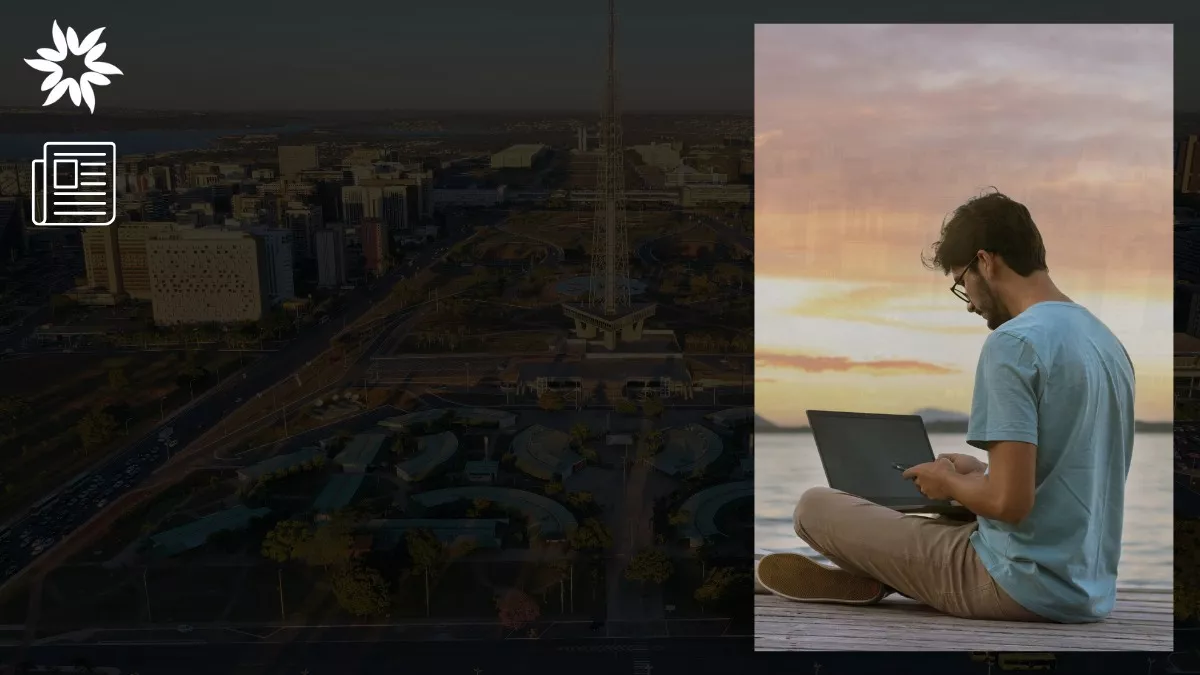Remote work has gone from being a perk to a lifestyle—and in 2025, it’s clearer that the digital nomad movement isn’t slowing down. What used to be a niche idea—working from a laptop while traveling the world—has become part of everyday life for millions.
According to a 2024 study by MBO Partners, more than 35 million people worldwide now identify as digital nomads. In the United States alone, 1 in 10 workers say they’re living and working remotely while on the move.
Remote work has made this lifestyle easier. More companies are letting people work from home or from anywhere. Digital tools make it simple to join meetings, send files, or talk to teams around the world.
Governments are noticing this, too. Countries like Brazil, Portugal, Spain, Barbados, Georgia, and Estonia have created digital nomad visas. These visas let remote workers stay longer and live legally while working online.
But when choosing where to go, you should also consider how much it costs to live there, how safe it is, how good the internet is, and whether there are other remote workers or travelers around you. It’s easier to feel at home when you find a place that fits your budget, your routine, and your personality.
This guide takes you through all of that and more based on detailed data, expert opinions, and the latest research.
Key Takeaways
- Brasília, Brazil, ranks #1 for digital nomads in 2025 due to its safety, affordability, and welcoming visa policy.
- New digital nomad visas and more flexible rules are expanding options in countries like Spain, Portugal, and Georgia.
- Genoa, Italy, tops Dojo’s global rankings, while cities like Taipei, Warsaw, and Siargao are quickly gaining popularity.
How the Rankings and Insights Were Compiled
The list of digital nomad destinations in this guide wasn’t made up or based on guesses. It comes from real data, expert advice, and personal experience from people who live this way.
One of the main sources was InsureMyTrip, a company that looked at a number of important things when ranking the best cities for digital nomads in 2025. They used facts like a country’s happiness score, how much it costs to live there, how safe it is, and how easy it is to get a digital nomad visa. They also looked at what to do in each place and how well it supports people working online. All of their data came from September 2024, so it’s up to date.
Another big source was the Dojo report, which studied 237 cities around the world. Dojo used details like internet speed, visa length and cost, the cost of things in each city, the freedom people have online, and whether a place is close to the beach.
Top 10 Best Cities for Digital Nomads in 2025 (InsureMyTrip Rankings)
InsureMyTrip looked at key factors like cost of living, safety, visa access, and things to do to rank the best cities for remote workers. Each of these digital nomad destinations offers some kind of legal visa option for remote work, along with a solid setup for living and working abroad.
Let’s go through each city one by one and explain why it made the top 10.
1. Brasília, Brazil
First on the list is Brasília, Brazil’s capital. Since January 2022, Brazil has had a digital nomad visa that lets remote workers live in the country for up to one year, with the option to renew. Brasília is safer than other major Brazilian cities and has a lower cost of living than many U.S. cities. The internet is reliable, and the weather is warm all year. The city is known for its modern buildings and open parks, which provide space to relax or work outside.
2. Budapest, Hungary
Next is Budapest, the capital of Hungary. It ranks high for safety and has a low cost of living. Hungary has a digital nomad visa called the White Card, which is open to non-EU citizens working remotely. Internet service is strong, and there are many coworking spaces. Budapest is also known for its historic sites, thermal baths, and busy city life. These features give nomads both comfort and interesting places to explore.
3. Montevideo, Uruguay
At number three is Montevideo, the largest city in Uruguay. Uruguay lets digital nomads apply for legal stay through a special visa for remote workers. A big drawing factor to Montevideo is its low crime rate and affordability. The internet is dependable, and the city has a few coworking spaces. It also has a laid-back lifestyle, beaches, and a growing arts scene, which makes it fitting for those who want to work and enjoy a slower pace.
4. Lisbon, Portugal
Since 2022, Portugal has had a digital nomad visa that lets remote workers stay for one year, with possible extensions. Lisbon is one of the most popular cities in Europe for nomads. The cost of living is lower than in many other Western European cities. Wi-Fi is fast, and there are many coworking spaces. The city has colorful streets, good weather, and a large community of remote workers, which helps people feel welcome.
5. Kuala Lumpur, Malaysia
Next is Kuala Lumpur, the capital of Malaysia. Malaysia has no official digital nomad visa, but remote workers often use tourist or business visas. Living in Kuala Lumpur is affordable, with low prices for food and rent. Internet access is strong, and the city has a good metro system. Coworking spaces are available across the city. There are also nearby beaches and rainforests, which gives workers an easy way to relax on weekends.
6. Madrid, Spain
In sixth place is Madrid, the capital of Spain. In 2023, Spain introduced a digital nomad visa that lets people stay for up to two years. Madrid is known for its art, music, and nightlife. The city has fast internet, plenty of coworking options, and strong public transport. Some locals are concerned about too many visitors, but Madrid still remains a top place for remote workers. Neighborhoods like La Latina have many cafés where people can work and meet others.
7. Nicosia, Cyprus
Nicosia, the capital of Cyprus, ranks seventh. Cyprus has a digital nomad visa that lets people stay for one year and have the chance to extend their stay. English is widely spoken, which helps foreigners settle in. The city is affordable and has a good happiness rating. The climate is warm and dry. The Internet is stable, and a few coworking places are available. Nicosia is a quiet, simple option for those who prefer a smaller city.
8. Buenos Aires, Argentina
Buenos Aires comes next. Argentina has launched visa programs to support digital nomads. The city is known for its culture, dance, and food. The cost of living is low, and internet access is good in most areas. Coworking spaces are available in many neighborhoods. Buenos Aires has markets, parks, and a mix of modern and old buildings. It’s easy to stay busy outside of work and to connect with others.
9. Podgorica, Montenegro
Podgorica, the capital of Montenegro, is number nine. Montenegro now has a digital nomad visa for up to two years. The city is very affordable and small enough to walk across. Modern cafés, coworking spaces, and historical areas from the Ottoman Empire. The internet is stable. It’s easy to reach beaches, lakes, or mountains, which makes it a peaceful choice for people who enjoy nature.
10. San Jose, Costa Rica
Finally, we have San Jose, the capital of Costa Rica. Costa Rica has a digital nomad visa that lets remote workers stay for one year if they meet income requirements. San Jose has reliable internet and more coworking spots than ever before. It’s also close to beaches and mountains, so weekend trips are easy. The city is known for its friendly people and relaxed way of life, which is often described by the phrase “pura vida.”
New and Emerging Nomad Hubs in 2025
While the usual cities like Lisbon and Buenos Aires are still popular, more digital nomads in 2025 are starting to look at places that offer something different. These new spots might not be at the top of every list yet, but they’re quickly getting attention.
What they have in common is affordability, decent internet, and a growing remote work community. Let’s go through a few cities that are now getting noticed by nomads who’ve been around.
Siargao, Philippines
Let’s start with Siargao, a small island in the Philippines. It’s becoming a go-to place for digital nomads who want to live near the ocean. The island has clear water, palm trees, and a relaxed pace. A big reason people go there is the surfing. But even if you don’t surf, it’s a good place for beach lovers.
Now, in terms of work, the internet is something to think about. Some nomads have said the connection can be slow or unstable, depending on where you stay. It works for emails or writing but might not be great for video calls.
That said, coworking spaces like Coco Space and Cowork Surf have opened up and are made for remote workers. You’ll find a friendly crowd there, and it’s easy to meet people. If you’re okay with slower Wi-Fi and want a chill, simple lifestyle, Siargao might be the right spot.
Taipei, Taiwan
Next is Taipei, the capital of Taiwan. It’s not exactly new, but it hasn’t been a major digital nomad city yet. That’s starting to change. People are realizing it’s a clean, safe, and easy-to-navigate place. Even though it’s a big city, it doesn’t feel crowded.
One big plus is the food scene—there’s a lot of good and cheap local food. The internet is fast, and the city has a strong infrastructure. You can also get out of the city pretty quickly and find mountains and green areas for a short break.
There aren’t as many coworking spaces as in cities like Bali or Chiang Mai, but there are still enough to work comfortably. And the locals are known for being kind and helpful, which makes a difference when you’re new to a place.
Melbourne, Australia
Moving over to Australia, Melbourne stands out for digital nomads who love city life. This city is well-known for its coffee, food, and art. You’ll find great cafés, different types of restaurants, and a creative vibe in many neighborhoods.
Public transport is easy to use, and the internet is reliable. There are also plenty of coworking spaces, so finding a place to work isn’t a problem.
But it’s important to point out that Melbourne is expensive. Prices have been going up, and while it’s still cheaper than Sydney, it’s not a budget option. Still, for nomads who have the money or are staying short-term, the quality of life is high, and the city has plenty to enjoy.
Warsaw, Poland
Now let’s look at Warsaw, the capital of Poland. It was ranked #2 on TimeOut’s list of cities rising in popularity for digital nomads, and for good reason. The city is clean, organized, and more affordable than most other European capitals.
Warsaw has fast internet, and the coworking scene is growing. It also has parks, museums, and a strong tech scene. Many locals speak English, especially in the city center, so getting around and making friends isn’t too hard.
The nomad community is still getting started here, but the setup is already good. For people who want to be in Europe without spending a lot, Warsaw is a safe bet.
Cape Town, South Africa
Another city that’s getting a lot of attention is Cape Town. TimeOut named it the best city to visit in 2025, and digital nomads are starting to take notice, too. It’s now #6 on NomadList, with strong ratings for cost, weather, and remote worker support.
Cape Town has a mix of mountains, beaches, and wine country, all close to the city. The internet is generally good, and there are many coworking spaces. The city also has a strong food and wine scene, which adds to the appeal.
One thing to keep in mind is safety. Some areas are safer than others, so it’s important to learn which neighborhoods are best for living and working. Many nomads say that once you know your way around and stay aware, the city has a great lifestyle and plenty to see and do.
Bucharest, Romania
Last is Bucharest, the capital of Romania. It’s still under the radar, but more people are starting to talk about it. Bucharest is very affordable, and Romania has fast internet, which is a big plus for remote workers.
The city has many French-style buildings, wide streets, and local cafés. There are coworking spaces, and the nomad community is starting to grow. It’s not as busy as Western European cities, but that’s part of the charm.
There’s also a lot to see outside the city. One popular place to visit is Bran Castle, which is often linked to the Dracula story. For nomads who want something different and budget-friendly, Bucharest is worth a look.
Top-Ranked Cities from Dojo’s Global Report
Let’s now look at another important list. Dojo, a UK-based payment company, released a report that ranked the best cities in the world for digital nomads in 2025. Dojo looked at internet speed, cost of living, visa length and cost, internet freedom, safety, and quality of life. They also checked official government websites to confirm digital nomad visa rules and details like cost and how long each visa lasts.
Italy: Genoa, Bari, Catania, Florence, Palermo
Starting with Italy, Genoa ranked #1 on Dojo’s list. It’s a coastal city in the Liguria region. Italy’s digital nomad visa costs $124 and is valid for 12 months. Genoa had the fastest internet speed in the whole report. It also got a security score of 27, a quality-of-life rating of 154.78, and an average cost of living of around $800 per month. It’s a quiet city with a port, great history, and easy access to the sea.
Next is Bari, in southern Italy. It had a quality-of-life score of 159.2, the same security score of 27, and a lower monthly cost of $650. Bari is known for its old town and seaside views, and it’s a bit more off the radar than Rome or Milan, which some nomads prefer.
Catania, in Sicily, is near Mount Etna. Its cost of living is also around $650, and its quality-of-life score is 141.82. It’s full of history and food markets and has a unique feel compared to northern cities.
Then there’s Florence, one of the most famous cities for art and architecture. It scored a quality-of-life rating of 155.6 and a security score of 27. Its cost of living is slightly higher, at $785/month. For nomads who enjoy history, museums, and a slower pace, Florence is a strong pick.
Finally, Palermo, also in Sicily, has a more affordable lifestyle. The monthly cost is $660, the security score is 27, and the quality-of-life score is 142.97. The city is known for its culture, warm weather, and easy access to the coast.
Spain: Valencia, Seville, Las Palmas, Madrid, Zaragoza
Now let’s move to Spain, which had several cities in the top rankings. Valencia came out as the top Spanish city. It had a quality-of-life score of 191.1, a safety score of 24, and a low cost of living at $585/month. Spain’s digital nomad visa costs $725 for 12 months. Valencia has beaches, parks, and reliable public transport, all at a lower cost than cities like Barcelona or Madrid.
Seville also ranked high. It had a quality-of-life rating of 182.82, a safety score of 24, and a monthly cost of around $590. The city is known for flamenco, tapas, and sunny weather. It’s a good fit for people who want local culture and a smaller city feel.
Las Palmas, in the Canary Islands, had a quality-of-life score of 188.06, a safety score of 24, and a monthly cost of $600. Since it’s on an island, you get warm weather year-round, along with beaches and coworking spaces. It’s great for nomads who want a slower pace without losing basic city comforts.
Madrid also made the list. It’s more expensive than some of the other cities but has strong internet, plenty of coworking spaces, and access to Spain’s digital nomad visa. For people who want big city life with history and nightlife, Madrid is a dream.
Zaragoza is less well-known, but worth a look. It’s more affordable, quieter, and still has solid infrastructure. It doesn’t have a beach or international crowd like other Spanish cities, but it’s a good choice if you prefer a calm and steady place to work.
Canada: Quebec City, Ottawa, Montreal, Hamilton, Oshawa
Finally, five cities in Canada made Dojo’s list. Quebec City ranked highest among them. Even though its internet speed is the lowest, at 35.2 Mbps, it scored well on other factors like cost of living ($725/month), internet freedom, and visa access. Canada has a free visa that lets nomads stay for up to six months.
Ottawa, Montreal, Hamilton, and Oshawa also scored well in terms of livability, safety, and access to services. Like Quebec City, they all fall under Canada’s short-term visa option, which is simple and free. Costs are higher than most cities in Europe, but for nomads looking for stability and clean, safe cities, these are good options.
Which City Fits Your Nomad Style?
The best city for you depends on how you like to live and work. Here’s a clear breakdown.
If you want something affordable and close to nature, Siargao in the Philippines is a good pick. It’s known for beaches, palm trees, and a slow pace. The internet isn’t always strong everywhere, but places like Coco Space and Cowork Surf have decent Wi-Fi and a spot to get work done. It’s best if you enjoy island life and don’t rely on heavy video calls every day.
Podgorica, Montenegro, is also quiet and cheap. It’s easy to walk around, and you’re close to both the sea and the mountains. The internet works well, and Montenegro has a two-year digital nomad visa.
Now, if you want a busy city with stuff to do, check out Madrid, Buenos Aires, or Melbourne. Madrid has lots of cafés, coworking spaces, and a visa that lets you stay up to two years. Buenos Aires is fun, full of culture, and very affordable. Melbourne has great food and coffee, but it’s more expensive than the others.
For something more organized and stable, go with Lisbon, Valencia, or Genoa. These cities are safe, have fast Wi-Fi, and have legal visas for remote workers. Valencia is one of the cheapest in Spain, at around $585 a month, and has a high quality-of-life score. Genoa, in Italy, has the fastest internet speed in a global study and has a visa for just $124.
For those who want a more tech-friendly setup, look at Taipei or Estonia. Taipei has fast internet, great public transport, and access to nature just outside the city. Estonia has a full digital nomad visa and an e-residency program, so you can even run a business online from anywhere.
So, think about what matters most—peace and nature, fast internet, big city life, or a mix. Then, choose a city that fits your style. The right digital nomad destination makes your remote life easier and better.








